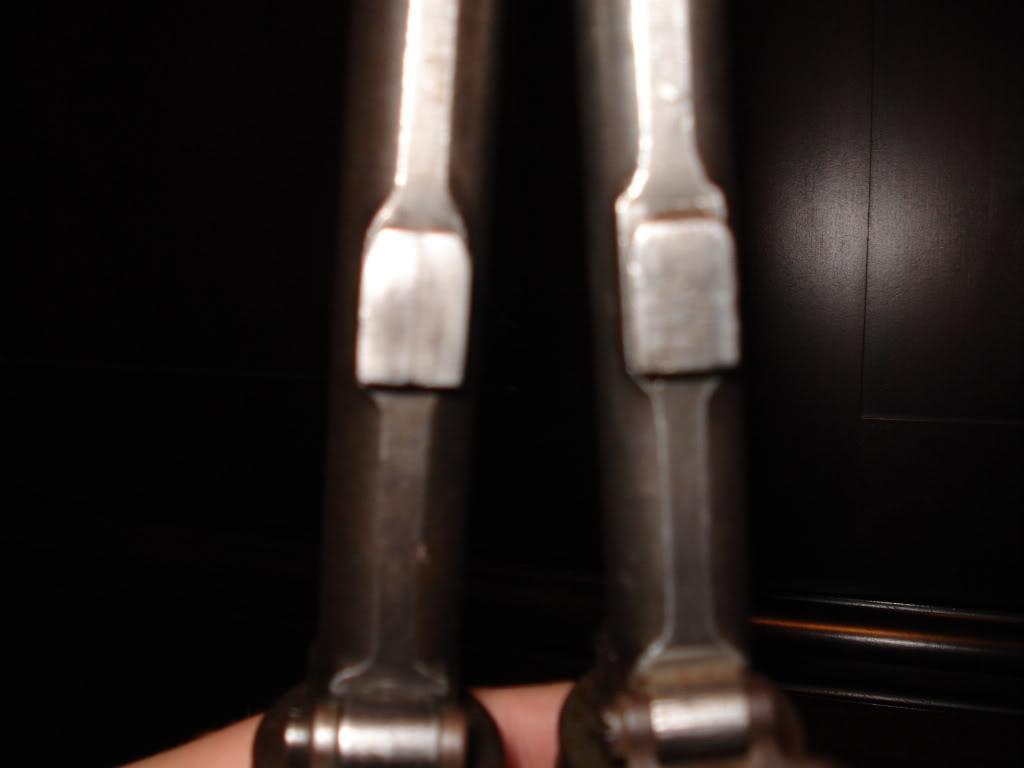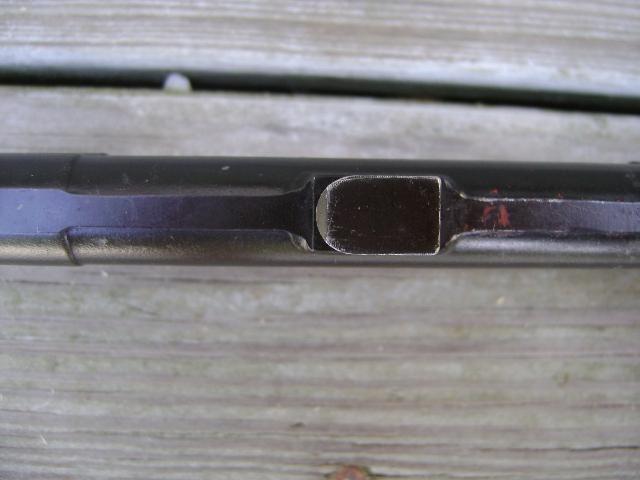show a picture the bayo lug (bottom View) - compare to a known springfield Gas cylinder
there are several points of difference
Wayne Bradford
Wayne Bradford
ihcfan55
06-16-2014, 10:43 PM
The football shape that is imaged does not automatically make it an IHC gas cylinder. I have seen WWII Springfield Armory gas cylinders that also had this same "football" shape around the bayonet lug.
Several people have wanted me to post "How to spot an IHC cylinder" on this forum. I have resisted thus far, because it seems that a lot of what I publish here gets into other people's books, and it is not credited to me; instead, the info I publish here is simply listed as a "Source" or "Sources say" in other books. Since you guys have asked over-and-over for a way to spot an IHC cylinder, here it is, verbatim from the rumored IHC book:
IHC: There are a number of identification features that can be examined in gas cylinder identification, and the process is really one of elimination. Use the following process of elimination, and if you can get through all eight ID steps, you probably have an IHC gas cylinder. Be aware that an arsenal rework will make it difficult to determine the origin of a gas cylinder, due to refinish and new stacking swivel screws.
1. Front sight base width: All IHC gas cylinders will have the wide base front sight platform. All gas cylinders with the narrow base front sight platform are of Springfield Armory WWII manufacture. A note concerning WWII Springfield wide base gas cylinders: On many of these, a small circular indent can be found just aft of the stacking swivel screw head, on the op rod side. This indent is small, about the size of a BB, and is shallow in depth. (No evidence has surfaced thus far to explain the circular indent.) If there is a BB indent in the right side of the gas cylinder in this location, then you have a WWII SA gas cylinder. So, if the front sight base is wide (and there is not a “BB” indent), advance to the Step 2.
2. Letter codes or numbers: IHC cylinders will NOT have a letter or number code on them (One M1reference book has stated that IHC gas cylinders exhibited letter codes, commonly the “C” code). However, the author has a copy of the original “Works Heat Code” directive (dated May 5, 1954), and gas cylinders were NOT on the list of parts to be stamped. Note: SA provided many parts to IHC in the summer of 1955, and gas cylinders may have been provided as well. The author has seen two SA gas cylinders on otherwise original IHC rifles in the 5.11M range, both of them with a “C” on the bayonet lug. If there is no letter code, go to step 3. But, if letters or numbers are present, then the cylinder is a WWII Springfield cylinder; that is, unless it is found on a rifle in the 5.11M to 5.14M range that has all IHC parts and no rebuild marks.
3. Punch marks: IHC gas cylinders will not exhibit any punch marks - if there are no punch marks go to step 4. If you have punch marks, the cylinder is either an SA or HRA cylinder.
4. Stacking swivel staking: IHC staking is generally offset, but center staking has been observed on some original examples. Note: Some early IHC rifles will have the gas cylinder stacking swivel screw on the wrong side (clip latch side) of the gas cylinder. (Per specifications, the screw head should be on the op rod side of the rifle.) If the staking is present, either offset or centered, go to step 5. If there are multiple stakes, or there are stakes that look more like punch marks, then the gas cylinder has gone through an arsenal rebuild, and the manufacturer will be difficult to determine.
5. Bayonet lug milling: IHC cylinders, particularly in the 4.40 to 4.65M ranges, normally exhibit distinictive milling on the bottom of the gas cylinder – found just forward (and aft) of the bayonet lug. The IHC gas cylinder milling in this area may have a smooth taper to it, with the taper looking somewhat like a “football." (Please be aware that some WWII SA cylinders also have this distinctive milling, so use your key ID features of letter codes or punch marks to rule out these WWII cylinders.) Many original IHC cylinders exhibit a look I call the “paintbrush” on the bottom of the cylinder, forward of the bayonet lug, which has squared off corners. These "paintbrush" ID features are found in the late IHC serial number ranges, particularly in the 5.00M to 5.21M ranges. In either event, go to step 6.
6. Finish: IHC cylinders have the finest finish, with the cylinders normally a rich jet black color. (Some HRA cylinders are just as nice.) Whether finished finely or note, advance to step 7.
7. Parkerizing of stacking swivel: IHC stacking swivels will normally not match the color of the gas cylinder, but will be a medium gray-green color. In either event, go on to step 8.
8. Stacking swivel screw head: This is one of the key identifiers in the whole identification process. The original IHC stacking swivel screw head normally exhibits concentric (or “ringed”) machine tool marks. If you can positively identify the first seven ID features, this “concentric ring” screw head is the final (and possibly the best) feature for identifying an IHC gas cylinder.
Note: Many WWII era Springfield Armory gas cylinders also have been observed with the concentric (“ringed”) screw as well - so in IHC gas cylinder identification, use your first seven steps to rule out these WWII SA cylinders. Also, many stacking swivel screws probably went to HRA and SA after IHC closed, as IHC had an excess inventory of 12,827 when they sold off their inventory. It is highly probable that many of these stacking swivel screws found their way onto SA and HRA rifles in early 1956.
Happy collecting. -- GWBInformation

Warning: This is a relatively older thread
This discussion is older than 360 days. Some information contained in it may no longer be current.
- Knowledge Library

- MKL Entry of the Month
- Australia
- Austro-Hungarian Empire
- Canada
- Czechoslovakia
- Denmark
- Finland
- France/Belgium
- Germany
- Italy
- Japan
- Norway
- Russia
- South America
- Sweden
- Switzerland
- Turkey
- United Kingdom
- United States
- Yugoslavia
- Is my rifle authentic or a fake?
- Jay Currah's Lee Enfield Web Site
- On-line Service Records (Canada)
- Technical Articles/Research
- Forum
- Classifieds

- What's New?
-
Photo Gallery

- Photo Gallery Options
- Photo Gallery Home
- Search Photo Gallery List
-
Photo Gallery Search
- Video Club

- iTrader












 PM
PM



